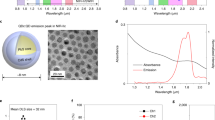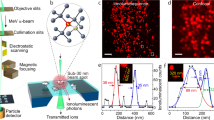Abstract
Metastasis is an impediment to the development of effective cancer therapies. Our understanding of metastasis is limited by our inability to follow this process in vivo. Fluorescence microscopy offers the potential to follow cells at high resolution in living animals. Semiconductor nanocrystals, quantum dots (QDs), offer considerable advantages over organic fluorophores for this purpose. We used QDs and emission spectrum scanning multiphoton microscopy to develop a means to study extravasation in vivo. Although QD labeling shows no deleterious effects on cultured cells, concern over their potential toxicity in vivo has caused resistance toward their application to such studies. To test if effects of QD labeling emerge in vivo, tumor cells labeled with QDs were intravenously injected into mice and followed as they extravasated into lung tissue. The behavior of QD-labeled tumor cells in vivo was indistinguishable from that of unlabeled cells. QDs and spectral imaging allowed the simultaneous identification of five different populations of cells using multiphoton laser excitation. Besides establishing the safety of QDs for in vivo studies, our approach permits the study of multicellular interactions in vivo.
This is a preview of subscription content, access via your institution
Access options
Subscribe to this journal
Receive 12 print issues and online access
$209.00 per year
only $17.42 per issue
Buy this article
- Purchase on Springer Link
- Instant access to full article PDF
Prices may be subject to local taxes which are calculated during checkout





Similar content being viewed by others
References
Chambers, A.F., Groom, A.C. & MacDonald, I.C. Dissemination and growth of cancer cells in metastatic sites. Nat. Rev. Cancer 2, 563–572 (2002).
Fidler, I.J. The pathogenesis of cancer metastasis: the 'seed and soil' hypothesis revisited. Nat. Rev. Cancer 3, 453–458 (2003).
Friedl, P. & Wolf, K. Tumour-cell invasion and migration: diversity and escape mechanisms. Nat. Rev. Cancer 3, 362–374 (2003).
Lewalle, J.M. et al. Alteration of interendothelial adherens junctions following tumor cell-endothelial cell interaction in vitro. Exp. Cell Res. 237, 347–356 (1997).
Voura, E.B., Chen, N. & Siu, C.H. Platelet-endothelial cell adhesion molecule-1 (CD31) redistributes from the endothelial junction and is not required for the transendothelial migration of melanoma cells. Clin. Exp. Metastasis 18, 527–532 (2000).
Voura, E.B., Ramjeesingh, R.A., Montgomery, A.M. & Siu, C.H. Involvement of integrin a(v)b(3) and cell adhesion molecule L1 in transendothelial migration of melanoma cells. Mol. Biol. Cell 12, 2699–2710 (2001).
Lim, D.S. et al. Antitumor efficacy of reticulol from Streptoverticillium against the lung metastasis model B16F10 melanoma. Lung metastasis inhibition by growth inhibition of melanoma. Chemotherapy 49, 146–153 (2003).
Yamaguchi, H. et al. Sphingosine-1-phosphate receptor subtype-specific positive and negative regulation of Rac and haematogenous metastasis of melanoma cells. Biochem. J. 374, 715–722 (2003).
Dove, A. MMP inhibitors: glimmers of hope amidst clinical failures. Nat. Med. 8, 95 (2002).
Al Mehdi, A.B. et al. Intravascular origin of metastasis from the proliferation of endothelium-attached tumor cells: a new model for metastasis. Nat. Med. 6, 100–102 (2000).
Naumov, G.N. et al. Persistence of solitary mammary carcinoma cells in a secondary site: a possible contributor to dormancy. Cancer Res. 62, 2162–2168 (2002).
Brown, E.B. et al. In vivo measurement of gene expression, angiogenesis and physiological function in tumors using multiphoton laser scanning microscopy. Nat. Med. 7, 864–868 (2001).
Wang, W. et al. Single cell behavior in metastatic primary mammary tumors correlated with gene expression patterns revealed by molecular profiling. Cancer Res. 62, 6278–6288 (2002).
Zhang, J., Campbell, R.E., Ting, A.Y. & Tsien, R.Y. Creating new fluorescent probes for cell biology. Nat. Rev. Mol. Cell Biol. 3, 906–918 (2002).
Jaiswal, J.K. & Simon, S.M. Potentials and pitfalls of fluorescent quantum dots for biological imaging. Trends Cell Biol. in the press.
Mattoussi, H. et al. Self-assembly of CdSe-ZnS quantum dot bioconjugates using an engineered recombinant protein. J. Am. Chem. Soc. 122, 12142–12150 (2000).
Wu, X. et al. Immunofluorescent labeling of cancer marker Her2 and other cellular targets with semiconductor quantum dots. Nat. Biotechnol. 21, 41–46 (2003).
Larson, D.R. et al. Water-soluble quantum dots for multiphoton fluorescence imaging in vivo. Science 300, 1434–1436 (2003).
Chan, W.C. et al. Luminescent quantum dots for multiplexed biological detection and imaging. Curr. Opin. Biotechnol. 13, 40–46 (2002).
Dabbousi, B.O. et al. (CdSe)ZnS core-shell quantum dots: synthesis and characterization of a size series of highly luminescent nanocrystallites. J. Phys. Chem. 101, 9463–9475 (1997).
Lim, Y.T. et al. Selection of quantum dot wavelengths for biomedical assays and imaging. Mol. Imaging 2, 50–64 (2003).
Mattoussi, H., Kuno, M.K., Goldman, E.R., George, P. & Mauro, J.M. in Optical Biosensors: Present and Future. (eds. F.S. Ligler & C.A. Rowe) 537–569 (Elsevier, The Netherlands, 2002).
Jaiswal, J.K., Mattoussi, H., Mauro, J.M. & Simon, S.M. Long-term multiple color imaging of live cells using quantum dot bioconjugates. Nat. Biotechnol. 21, 47–51 (2003).
Fidler, I.J. Biological behavior of malignant melanoma cells correlated to their survival in vivo. Cancer Res. 35, 218–224 (1975).
Fidler, I.J., Pollack, V.A. & Hanna, N. The use of nude mice for studies of cancer metastasis in immune-deficient animals. in 4th International Workshop on Immune-Deficient Animals in Experimental Research 328–338 (Karger, New York, 1984).
Zuhorn, I.S. & Hoekstra, D. On the mechanism of cationic amphiphile-mediated transfection. To fuse or not to fuse: is that the question? J. Membr. Biol. 189, 167–179 (2002).
Clark, P.R. & Hersh, E.M. Cationic lipid-mediated gene transfer: current concepts. Curr. Opin. Mol. Ther. 1, 158–176 (1999).
Dickinson, M.E., Simbuerger, E., Zimmermann, B., Waters, C.W. & Fraser, S.E. Multiphoton excitation spectra in biological samples. J. Biomed. Opt. 8, 329–338 (2003).
Ballou, B., Lagerholm, B.C., Ernst, L.A., Bruchez, M.P. & Waggoner, A.S. Noninvasive imaging of quantum dots in mice. Bioconjug. Chem. 15, 79–86 (2004).
Derfus, A.M., Chan, W.C.W. & Bhatia, S.N. Probing the cytotoxicity of semiconductor quantum dots. Nano Letters 4, 11–18 (2004).
Acknowledgements
This work was supported by the Cancer Research Institute (E.B.V.), the American Cancer Society (RPG-98-177-01-CDD, S.M.S.) and the National Science Foundation (NSF BES-0119468, S.M.S.). H.M. acknowledges K. Ward and A. Ervin at the Office of the Naval Research for research support (ONR N001400WX20094). The views, opinions and findings described in this report are those of the authors and should not be construed as official Department of the Navy positions, policies or decisions. The authors wish to thank A. North and the Bio-Imaging Resource Center of Rockefeller University and B. Sanchez from the Rockefeller University Laboratory Animal Resource Center, for excellent support.
Author information
Authors and Affiliations
Corresponding author
Ethics declarations
Competing interests
The authors declare no competing financial interests.
Supplementary information
Supplementary Fig. 1
Quantum dots can be seen over tissue background. (PDF 105 kb)
Supplementary Fig. 2
Emission spectra of DHLA-capped QDs is not affected by aldehyde fixation. (PDF 254 kb)
Rights and permissions
About this article
Cite this article
Voura, E., Jaiswal, J., Mattoussi, H. et al. Tracking metastatic tumor cell extravasation with quantum dot nanocrystals and fluorescence emission-scanning microscopy. Nat Med 10, 993–998 (2004). https://doi.org/10.1038/nm1096
Received:
Accepted:
Published:
Issue Date:
DOI: https://doi.org/10.1038/nm1096
This article is cited by
-
Antibacterial Activity of CdTe/ZnS Quantum Dot-β Lactum Antibiotic Conjugates
Journal of Fluorescence (2024)
-
Smart Peptide/Au Nano-carriers for Drug Delivery Systems: Synthesis and Characterization, Interactions with Calf Thymus DNA, and In Vitro Cytotoxicity Studies
Journal of Cluster Science (2023)
-
Co-axial electrospraying of injectable multi-cancer drugs nanocapsules with polymer shells for targeting aggressive breast cancers
Cancer Nanotechnology (2022)
-
Hybrid material of structural DNA with inorganic compound: synthesis, applications, and perspective
Nano Convergence (2020)
-
High-efficiency colloidal quantum dot infrared light-emitting diodes via engineering at the supra-nanocrystalline level
Nature Nanotechnology (2019)



